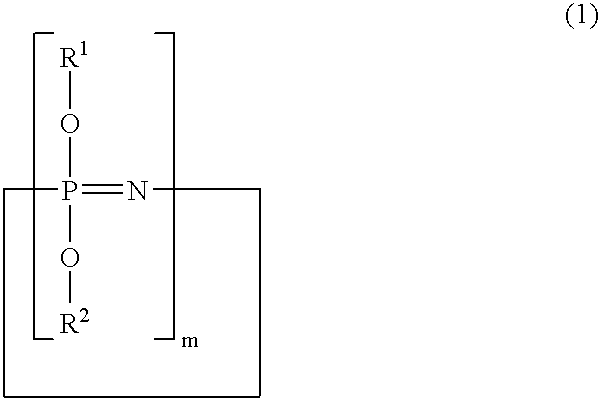Phosphazene compound, photosensitive resin composition and use thereof
a technology of resin composition and phosphazene, which is applied in the direction of photomechanical equipment, group 5/15 element organic compounds, instruments, etc., can solve the problems of insufficient inability to sufficiently make use of polyimide film performance, and inability to form holes and the like, and achieve excellent flame retardancy balance
- Summary
- Abstract
- Description
- Claims
- Application Information
AI Technical Summary
Benefits of technology
Problems solved by technology
Method used
Image
Examples
embodiment 1
[0082]The following will explain Embodiment 1 of the present invention. Note that, the present invention is not limited to this.
(A) Phosphazene Compound
[0083]The phosphazene compound according to the present invention is a compound obtained by reacting a phenoxyphosphazene compound (A-1) having a phenolic hydroxyl group, and / or a cross-linked phenoxyphosphazene compound (A-2) obtained by cross-linking the phenoxyphosphazene compound (A-1), and / or an isocyanate compound (C), and the phosphazene compound has an unsaturated double bond in its molecule.
[0084]The phenoxyphosphazene compound (A-1) and / or the cross-linked phenoxyphosphazene compound (A-2) are included, so that it is possible to give flame retardancy without losing the heat resistance of the obtained photosensitive resin composition. Particularly, the phosphazene compound used in the present invention has a phenolic hydroxyl group in its molecule, so that the phenolic hydroxyl group remarkably improves compatibility with re...
embodiment 2
[0273]The following description explains Embodiment 2 of the present invention. Note that, the present invention is not limited to this.
[0274]The photosensitive resin composition according to the present embodiment includes at least the polyimide resins (G) and the phosphazene compound (H), and further includes (meth)acrylic compounds (I). Among them, as the polyimide resins, the soluble polyimide resin (G-1) which has a carboxyl group and / or a hydroxyl group and is soluble in an organic solvent is used. As the phosphazene compound (H), the phenoxyphosphazene compound (H-1) having a phenolic hydroxyl group and / or the cross-linked phenoxyphosphazene compound (G-2) obtained by cross-linking the phenoxyphosphazene compound (H-1) is used.
[0275]The photosensitive resin composition according to the present invention uses the soluble polyimide resin (G-1) having a carboxyl group and / or a hydroxyl group. On this account, it is possible to give the heat resistance, the anti-bending property,...
embodiment 3
[0402]A photosensitive resin composition according to the present embodiment is a composition containing a soluble polyimide resin (K) having a carboxylic group and / or a hydroxyl group, a specific phenoxyphosphazene compound (L), and (meth)acrylic compounds (M). The photosensitive resin composition according to the present embodiment may further contain an other component (N), if necessary. For example, the photosensitive resin composition according to the present embodiment may further contain a compound, which gives a property such as adhesiveness, flame retardancy, heat resistance, anti-bending, and / or the like to a resultant photosensitive dry film resist. A photosensitive dry film resist according to the present embodiment is prepared from the photosensitive resin composition according to the present embodiment. In the following, each component is described.
[0403]The photosensitive resin composition according to the present embodiment contains the soluble polyimide resin having...
PUM
| Property | Measurement | Unit |
|---|---|---|
| temperature | aaaaa | aaaaa |
| pressure | aaaaa | aaaaa |
| temperature | aaaaa | aaaaa |
Abstract
Description
Claims
Application Information
 Login to View More
Login to View More - R&D
- Intellectual Property
- Life Sciences
- Materials
- Tech Scout
- Unparalleled Data Quality
- Higher Quality Content
- 60% Fewer Hallucinations
Browse by: Latest US Patents, China's latest patents, Technical Efficacy Thesaurus, Application Domain, Technology Topic, Popular Technical Reports.
© 2025 PatSnap. All rights reserved.Legal|Privacy policy|Modern Slavery Act Transparency Statement|Sitemap|About US| Contact US: help@patsnap.com



